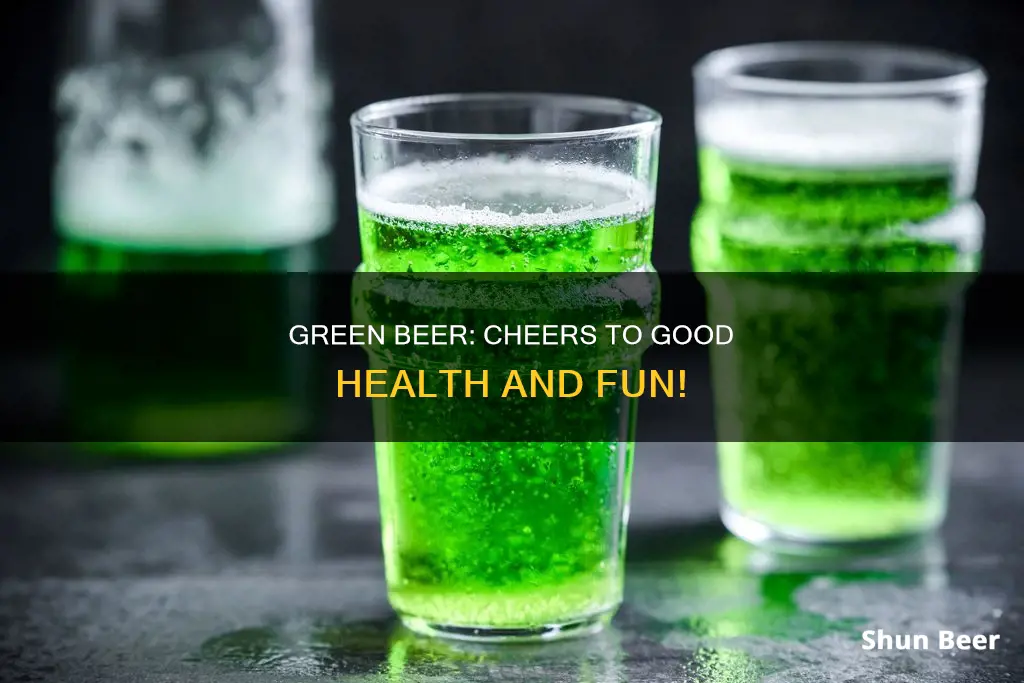
Green beer is a fixture at St. Patrick's Day celebrations, but the tradition did not originate in Ireland. It was created in the United States by a coroner's physician and eye surgeon, Dr. Thomas Curtin, who first coloured beer for a St. Patrick's Day celebration in 1914. While green beer is often associated with St. Patrick's Day, it can also refer to beer that has undergone primary fermentation but has not yet been conditioned, clarified, or matured. This green beer is drinkable but not ready for consumption and is generally cloudy with unsettled yeast.
| Characteristics | Values |
|---|---|
| Occasion | St. Patrick's Day |
| Origin | United States |
| Original recipe | Fabric or textile dye |
| Modern recipe | Blue food colouring |
| Health effects | Potential gastrointestinal distress with diarrhoea |
| Other effects | Green teeth |
What You'll Learn

The tradition of drinking green beer on St. Patrick's Day
Drinking green beer on St. Patrick's Day is a tradition that began in the United States over a century ago. While the Irish have a tradition of "drowning the shamrock", where drinkers add green shamrocks to their drinks for good luck, the act of dyeing pints of beer green is purely American.
To make green beer at home, it is recommended to use a light-coloured beer, as the lighter the beer, the better it shows off the food colouring. A light beer such as a blonde, pale ale, or pilsner is a good choice. When adding the food colouring, start with just a few drops at a time until you achieve the desired shade of green.
Drinking 12 Beers Daily: Is It Deadly?
You may want to see also

The potential health side effects of drinking green beer
Green beer is a fixture at St. Patrick's Day parties. While drinking green beer may be harmless, consuming large quantities of it may cause some gastrointestinal issues. Gastroenterologist Dr. Partha Nandi explains that artificial dyes are not meant to be consumed in large amounts and can cause diarrhea. In addition, artificial dyes are not easily absorbed by the body and can cause stools to be discolored.
Another possible side effect of drinking green beer is green teeth, which usually only occurs when there is moderate plaque buildup. According to dentist Joseph Roberts, the green food coloring in beer stains the bacterial cell walls in plaque.
Dr. Nandi also warns that excessive drinking can lead to liver disease, heart disease, certain forms of cancer, and pancreatitis. Therefore, it is recommended to limit alcohol consumption to no more than one drink per day for women and no more than two drinks per day for men.
The Magic of Beer Guns: Filling and Foaming Perfection
You may want to see also

The best way to dye beer green
Green beer is a fixture at St. Patrick's Day parties, but it's not an Irish tradition. The tradition started in the US and is believed to have been created by a doctor, Dr. Thomas Curtin, in 1914.
If you want to make green beer at home, it's quite simple. All you need is a light-coloured beer and green food colouring. The lighter the beer, the brighter the green will be, so a pilsner or an ale is a good choice. Budweiser, Miller, Busch, and Coors are popular options.
To make the beer green, add a few drops of green food colouring to a clear glass. Then, slowly pour in your beer of choice and watch the colour change. You can add more food colouring if you want a more vibrant shade.
If you want to avoid using artificial food colouring, there are natural alternatives such as wheatgrass juice, spirulina, or matcha powder. These options will impart a mild flavour to the beer, so choose one that you think will taste good with your beer. For example, wheatgrass juice will give the beer a grassy undertone, while matcha powder will add a mild green tea flavour.
Keep in mind that consuming large amounts of artificial food colouring can potentially cause digestive issues, so it's best to enjoy green beer in moderation.
Drinking Beer in Your Car: Missouri's Laws Explained
You may want to see also

The history of green beer
Green beer is a fixture at St. Patrick's Day parties, but it is not an Irish tradition. It is, in fact, an American innovation that was invented by an Irish American, Dr Thomas Hayes Curtin, over a century ago in New York City.
In 1914, Dr Curtin unveiled his invention of a beer the colour of shamrocks at a Bronx social club. According to an eyewitness, everything at the banquet was green or decorated in green, and Irish songs were sung while green beer was served. The beer was not served in a green glass, but in a regular, colourless glass. However, the amber hue of the beer had been replaced by a deep green.
Dr Curtin would only reveal that the green colour was achieved by adding one drop of "wash blue" to a certain quantity of beer. "Wash blue" was an iron powder solution used to whiten clothes and was, in fact, poisonous. Fortunately, today, a few drops of green food colouring are used instead to give the beer its distinctive emerald hue.
Although Dr Curtin is generally credited with the invention of green beer, other green beers appeared at the same time or slightly earlier. In 1910, the Spokane Press reported that the First Avenue Bar served green beer to patriotic Irishmen and anyone else who wanted to drink a green brew. By the 1950s, green beer had become a mainstream symbol of St Patrick's Day, which was becoming less specifically Irish and more American. The tradition then spread across the United States and eventually went international.
Mixing Beer and Gin: Safe or Not?
You may want to see also

The process of brewing green beer
Brewing green beer follows the same process as brewing any other beer, but with a few additional steps. Firstly, it's important to note that "green beer" has two meanings: beer that is literally green in colour, usually for St. Patrick's Day, and beer that hasn't matured enough and is not yet ready to drink. This answer will focus on the process of brewing green beer in the traditional sense, but will also touch on the steps required to make beer green in colour.
The first step in brewing beer is to malt the barley, wheat, oats or rye. This involves germinating the grain in a malt house, drying it in a kiln, and sometimes roasting it. The grain is then cracked open in a grist mill to expose the starches, and it is combined with water and heated in a process called mashing. This activates natural enzymes in the malt, which break down starches into sugars. Different temperatures activate different enzymes and affect the release of proteins and fermentable sugars, so this process requires a lot of skill and expertise.
The next step is lautering, which separates the wort (the liquid consisting of sugars and hot water) from the spent grain. The wort is then boiled in a brew kettle, and hops are added to impart bitterness, flavour and aroma. After boiling, the wort is cooled and transferred to a fermentation vessel, where yeast is added. The yeast converts the sugars in the wort into alcohol and carbon dioxide, creating either an ale or a lager depending on the type of yeast used.
Once primary fermentation is complete, the beer is considered "green" and is drinkable but not fully matured. Conditioning is the process of improving the green beer's flavour and stability, and it can take anywhere from one hour to six weeks. During conditioning, the yeast consumes byproducts of fermentation, such as diacetyl, which removes undesirable flavours from the beer. The yeast and other particles also settle out of suspension, resulting in a clearer beer. Conditioning can take place in a secondary fermentation vessel, or in the bottle or keg.
Now, to make the beer green in colour, food colouring or dye is added. However, it's important to note that consuming artificial dyes in large quantities can potentially cause digestive issues. Natural dye alternatives are available, but it can be difficult to determine the makeup of the food colouring used unless the ingredients are listed on the label.
Overall, brewing green beer requires a lot of knowledge, skill and patience. Following the correct processes and allowing the beer to mature adequately will result in a high-quality, delicious drink.
Keto and Craft Beer: Is It Possible to Enjoy Both?
You may want to see also
Frequently asked questions
Consuming green dye is generally harmless, but ingesting large quantities of it may cause gastrointestinal distress and diarrhea.
To make green beer, start by choosing a light beer, such as a blonde, pale ale, or pilsner. Then, add a drop of green or blue food coloring at a time until you achieve the desired color. Alternatively, you can use natural colorants such as matcha, green plants, or candy, but be mindful of the taste they may impart.
The tradition of drinking green beer on St. Patrick's Day is said to have originated in the United States. According to historical records, Dr. Thomas Curtin, a coroner's physician and eye surgeon, first colored beer for an annual St. Patrick's Day celebration in the Bronx, New York, in 1914.







